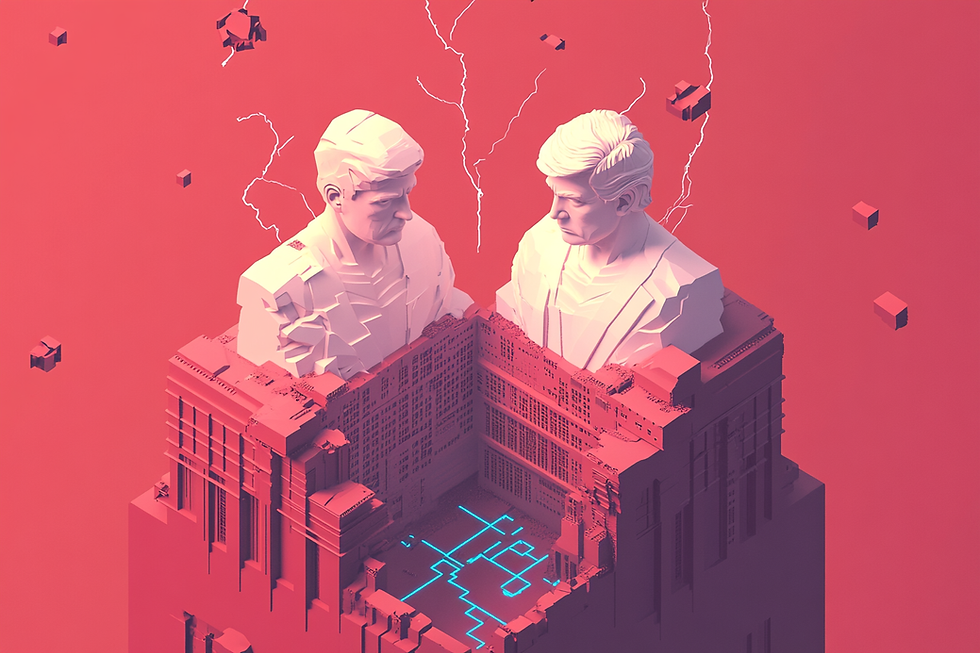What the Musk–Trump Rift Might Mean for AI
- Yoshi Soornack
- Jun 8
- 3 min read

It was always a fragile alliance.
One man built rockets and machines. The other built walls and movements. But for a brief moment, Elon Musk and Donald Trump stood side by side in a shared disdain for regulation, media, and anything that looked like ‘woke’ tech.
Now, their fallout is unfolding like a slow earthquake. Small tremors here, structural fractures there. And it’s sending signals far beyond the political theatre. Especially for those of us building with AI.
The Cost of Personality-Driven Innovation
Let’s start with the obvious. This isn’t just a clash of egos, it’s a systems-level disturbance. When Trump threatened to cancel federal contracts with Musk’s companies, including SpaceX and Tesla, it wasn’t just about a grudge. It was a reminder of how deeply modern innovation is bound to political favour.
The result? Tesla lost over $150 billion in a single day, its largest ever single-session drop. xAI’s funding deal reportedly stumbled as investors grew wary of reputational risk and political volatility.. And suddenly, AI’s forward motion in American industry felt uncertain.
This is the risk of innovation built on individual influence. When the hand that funds you decides to swat you down, the system doesn’t just pause. It tilts.
AI Adoption at a Crossroads
For those watching how AI is shaping construction, infrastructure, and energy, this matters.
Trump’s new bill shifted support away from electric vehicles and clean tech, cutting tax credits and reprioritising fossil fuel incentives. Musk called it “a disgusting abomination” and openly attacked the administration on social media. Trump retaliated publicly, suggesting Musk’s companies were over-subsidised and replaceable.
But behind the noise, we’re seeing a redistribution of incentives. The system is quietly pulling resources back to legacy sectors.
When public money starts favouring roads and rigs over smart infrastructure, the business case for intelligent systems gets weaker. Not because they don’t deliver, but because the ecosystem no longer rewards them.
And where incentives go, adoption usually follows.
We’ve Been Here Before
There are echoes from the past. Reagan’s cuts to renewable energy in the 1980s set the sector back by a decade. The Microsoft antitrust case in the 1990s distracted the company and opened the field for Google and others to rise.
Political moments have always redirected innovation.
But this one feels more delicate. AI doesn’t sit in a single domain. It runs beneath everything. Planning, prediction, performance. It’s becoming the substrate of how we deliver.
Which means disruption here doesn’t stay local. It spreads.
Four Futures from Here
Where does this go? A few possibilities:
Quiet reconciliation – Musk and Trump patch things up. Collaboration returns. AI-linked projects stabilise and federal funding keeps flowing. White House insiders have reportedly tried to broker peace to prevent further market fallout.
Splintered development – The divide deepens. Trump aligns with OpenAI, Oracle, and the $500 billion Stargate initiative. Musk doubles down on Grok, Starlink, and Neuralink. Competing ecosystems emerge, each with their own goals and values.
A new political mood – Voters grow tired of personality politics. Momentum builds around a more stable, systems-led approach to AI governance. Musk has floated the idea of a centrist third party representing the “moderate 80%”.
Global realignment – Innovation drifts abroad. Musk deepens ties in China and the Gulf, where he already has major deals. The centre of gravity shifts, and with it, the pace of progress.
Why It Matters to Project Delivery
We often see politics and project delivery as separate. But moments like this show how closely they run together.
If AI becomes entangled in cultural or political conflict, it won’t just be policy that suffers. It could disrupt progress on the ground. From digital twins and supply chain models to intelligent scheduling and risk profiling, the tools we rely on need more than code. They need systemic support.
This story might look like a fallout between two powerful men. But it raises a question for all of us working in the built environment. Can we truly scale AI if the systems that shape its future are still held together by personal loyalty and public drama?
The answer may not be clear yet. But how we respond will shape the foundations of what comes next.

Comments